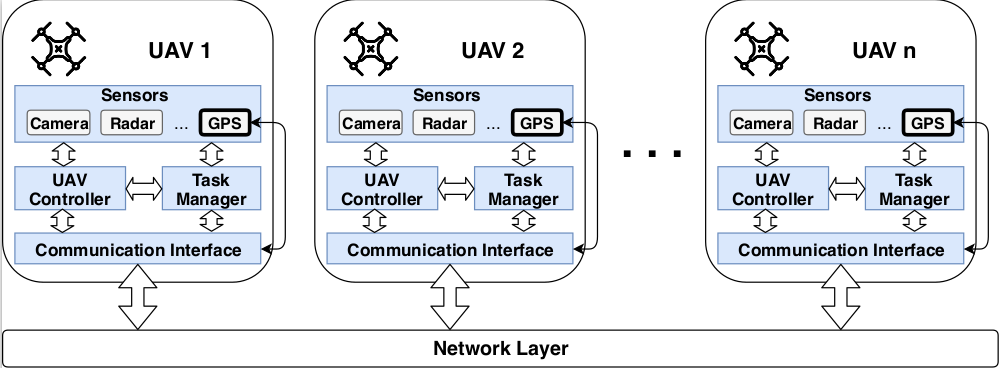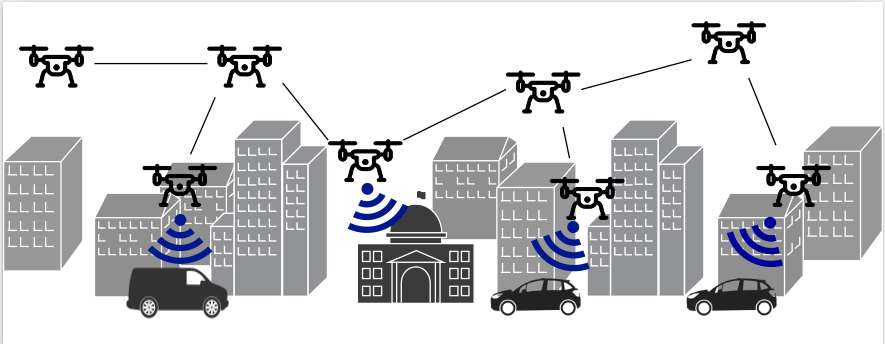Research Interests
Data Propagation over Networks Connecting Objects in Land, Air and Cyberspace
The advent and proliferation of smart vehicles, ranging from cars to Unmanned Aerial/Airborne Vehicles (UAVs), has opened numerous opportunities. UAVs are autonomous and flying devices able to operate in many diverse contexts thanks to their mobility. It is hence easy to foresee a future with many smart and connected devices moving around, creating what we call Smart Environments, characterized by the deployment of infrastructures and services that rely on Information and Communication Technology (ICT) solutions.
Recently, UAVs reached efficient communication capabilities, making them suitable for multi-UAV systems, consisting of a swarm of flying devices connected with each other and forming an ad-hoc network, called Flying Ad-hoc Network (FANET). In this context, the UAVs perform a distributed task and generate a continuous multihop flow of information to support local smart environment applications. A FANET owns several unique characteristics that makes it different from other systems, one of these, the possibility to extend enormously the operation coverage using ad-hoc communication.

A Smart Environment could be present in cities, where an Internet of Things (IoT) communication could be exploited even for local message exchange amongst people, cars, devices, buildings, urban objects, etc. They might share text, voice, images, videos, online gaming, music, news and advertisement, even resorting to data generated elsewhere (e.g., a drone in the sky above them). Such type of city is called Smart City. UAVs seem to be a perfect match for the context, enabling information exchange amongst UAVs from/to infrastructure to have an accurate picture about the urban conditions in a specific area, or for vehicular traffic assessment, pollution sensing, coordinated movements, warnings, etc. For example, UAVs could be equipped with cameras and a variety of sensors, providing a bird’s eye view for the ground rescue teams in that region(s), and can capture in real time visuals of different security situations and scenarios in both road and train networks.
Nevertheless, the potentiality of UAV applications in Smart Environments introduces many critical communication issues. Classic ad-hoc routing protocols, based on topology information, have generally been designed not considering particular characteristics, like high network sizes, high mobility, dynamic topology, dynamic traffic. These protocols perform very poorly when moving to smart environments.

The new project aims to move the focus on future potential application scenarios in a FANET system, where the UAVs may autonomously cooperate to perform specific un/common tasks. The challenge is to study the peculiar aspects of these applications, in terms of information data types, involved agents, objectives, planned movements, requirements, criticity and analyze how the communication aspect performs under these uncharted situations.
Furthermore, due to the lack of a simulation tool support for specific FANET and smart scenarios (3D topology, mobility models, position-based routing protocol assets), the project will advance in this direction, providing a simulation system linked to the Network Simulator 3 (a well-know event-driven simulator tool for network analysis). A simulation module specifically designed for FANETs and related smart applications could be included into NS-3 facilitating the research of innovative solutions for particular contexts. Also, the inclusion of test-bed environment objects, obstacles, realistic protocols and mobility models, aerodynamic factors and other aspects, may give an added value to the simulation realism.
Other Research Interests
- Network routing protocols design
- Highly mobile ad-hoc networks
- Internet of Things
- Web Application/Services
- Arduino Design and IoT
